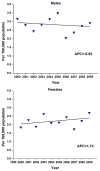Trends in the occurrence of high-grade anal intraepithelial neoplasia in San Francisco: 2000-2009
- PMID: 23861091
- PMCID: PMC4535426
- DOI: 10.1002/cncr.28252
Trends in the occurrence of high-grade anal intraepithelial neoplasia in San Francisco: 2000-2009
Abstract
Background: Although screening of human immunodeficiency virus (HIV)-positive individuals for anal intraepithelial neoplasia (AIN; a precursor of anal cancer) has been practiced in San Francisco among HIV health care providers since the early 1990s, to the authors' knowledge no study to date has focused on evaluating recent AIN trends.
Methods: Cases of high-grade AIN 3 and invasive anal cancer from 2000 to 2009 were obtained from the San Francisco/Oakland Surveillance, Epidemiology, and End Results (SEER) population-based cancer registry. Age-standardized rates of AIN 3 and anal cancer were calculated overall and by demographic characteristics (sex, race, and age group). Log-linear regression calculated annual percent change in rates during 2000 to 2009, and rate ratios (RRs) and 95% confidence intervals (95% CIs), evaluated differences in rates during 2000 through 2004 and 2005 through 2009.
Results: During 2000 through 2009, the majority of AIN 3 cases occurred among men (1152 of 1320 men; 87.3%). Rates of AIN 3 during the corresponding period increased by 11.48% per year (P < .05) among men and were stable among women. Comparing rates among men during 2000 to 2004 with those during 2005 to 2009, the largest increases were noted among those aged 50 years to 64 years (RR, 2.47; 95% CI, 1.93-3.17) and among black individuals (RR, 3.49; 95% CI, 2.14-5.85). During the same period, anal cancer rates were stable among men and women.
Conclusions: Rates of AIN 3 increased in San Francisco during 2000 through 2009, in conjunction with an anal cytology screening program for high-risk groups, whereas rates of invasive anal cancer were unchanged. Continued surveillance is necessary to evaluate the impact of screening and human papillomavirus vaccination on the prevention of human papillomavirus-related AIN and anal cancer.
Keywords: anal cancer; anal intraepithelial neoplasia; incidence; screening.
Copyright © 2013 American Cancer Society.
Conflict of interest statement
CONFLICT OF INTEREST DISCLOSURES
Dr. Clarke has received a grant from the National Cancer Institute. Dr. Palefsky is a member of the boards of Merck and Company and Pharmajet, and has received travel support from Merck. He has also received grants from Merck and Hologic and has acted as a member of the Speakers’ Bureau for Hologic. Dr. Palefsky also owns stock in Aura Biosciences.
Figures


References
-
- Schiffman M, Kjaer SK. Chapter 2: natural history of anogenital human papillomavirus infection and neoplasia. J Natl Cancer Inst Monogr. 2003;(31):14–19. - PubMed
-
- Kreuter A, Potthoff A, Brockmeyer NH, et al. Anal carcinoma in human immunodeficiency virus-positive men: results of a prospective study from Germany. Br J Dermatol. 2010;162:1269–1277. - PubMed
-
- Scholefield JH, Castle MT, Watson NF. Malignant transformation of high-grade anal intraepithelial neoplasia. Br J Surg. 2005;92:1133–1136. - PubMed
-
- Watson AJ, Smith BB, Whitehead MR, Sykes PH, Frizelle FA. Malignant progression of anal intra-epithelial neoplasia. ANZ J Surg. 2006;76:715–717. - PubMed
-
- de Pokomandy A, Rouleau D, Ghattas G, et al. HAART and progression to high-grade anal intraepithelial neoplasia in men who have sex with men and are infected with HIV. Clin Infect Dis. 2011;52:1174–1181. - PubMed
MeSH terms
Grants and funding
LinkOut - more resources
Full Text Sources
Other Literature Sources
Medical

